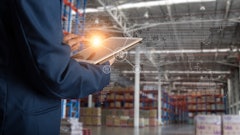
As the Food Safety Modernization Act (FSMA) rules are unraveled, new FDA demands for food safety during transportation are on the close horizon. For fence sitters, it is imperative to remember that the side of the FDA that deals with drugs and medical devices has clearly set the direction that food safety will continue to move in. The rules and regulations we see coming from Washington D.C. today represent only the early stages required to move food safety from a laissez-faire attitude into a generation of significant change.
The recent NBC Bay Area (www.nbcbayarea.com) report on Sysco and recently publicized Rossen reports from the Today show are clear indicators of the unhealthy status of the food transportation industry. When food enters the transportation sector from farms, processors and distributors and travels an average of over 2,000 miles to today’s American consumer, it enters what is becoming known as the black hole where rules are not applied or monitored.
The existence of this transportation black hole is evidence that we have failed to devise or accept a system to measure and manage the health of a very large part of the overall food supply—transportation. Let’s face it; transportation represents the blood line that moves nutrients through our food system’s body. That fact makes transportation and all related logistics activities critical to the overall food supply equation. More importantly, when things go wrong, we have no idea that they might have gone wrong and no way to correct the problem. No measurement means we are not in control and no control means management is not engaged.
Regardless of what may or may not happen to Sysco, put yourself in the place of the restaurants and retailers who use Sysco’s services. Both have become liability targets because they employ Sysco to deliver food. Consumers are certain to attach the overall public embarrassment to the retail outlet when they see that big Sysco truck delivering to the back door. It no longer takes much imagination to wonder where the food has been and how it has been handled. As consumers, we can rely on the news media to keep us informed.
Then put yourself in the place of the farms, packing houses and distributors who have done all they can to protect the food while it is in their custody—only to find out they have been two-timed by transportation. As blame migrates from the consumer end into the retail and restaurant industries, it continues down the supply chain to the origin—the farm. It is difficult to imagine that farms will happily accept responsibility for such transporter abuses when reverse logistics is involved in returning or dumping goods that were in prime condition when shipped.
All food logistics personnel have now suffered a black eye and are becoming increasingly viewed as a significant part of what is now viewed as “the problem.” Unrefrigerated dirty storage shed use and similar practices may be necessary in countries without the developed food safety infrastructure we have in the U.S. They are however, highly questionable here and may be interpreted to smack of intentional adulteration.
Some proactive companies are moving aggressively to implement standards, controls and practices that will meet not only FSMA rules, but bring them into line with industry demands. The rest of the food transportation sector needs to bite the bullet and get on with needed changes.
But of course, it is more convenient to fence sit until someone tells you what to do. That’s human nature and it is often disguised as “we can’t afford it.”
What this all means is that there must be food safety and quality transportation standards accepted and implemented by the industry. The simplest choice is to wait for the government to do it. Standards and practices for management, HACCP plans and implementation, sanitation, traceability and temperature controls will impact food logistics personnel prompting new training, procedures, inspection and technology. The new technology will require real-time container visibility designed to serve shippers, receivers and transporters. And don’t forget the record keeping that will generate unique container identification use, load, sanitation, traceability and temperature control data that ties the supply chain into a process rather than allowing avoidance through the “one up and one down” concept.
The “one up and one down” thinking is on its way out. Moving food through a supply chain is a process that can be defined, measured, managed and corrected. Data loggers, infrared temperature readers and the like will be replaced by more sophisticated technologies that capture and record shipment locations, identification and conditions and tie those data to the container in question. Not having such data simply means that the FDA or USDA or even the Indiana State police can stop, seize, hold or destroy shipments and charge for the time it takes them do it.
With food moving through long distance international supply routes, importers of perishables into the U.S. and other countries sharing similar food safety views need to be aware of new FSMA food safety import rules designed to slam the door on unscrupulous suppliers and transporters.
Employing commonly accepted transporter practices that threaten to adulterate food is a dangerous game to play.
Dr. John Ryan is a retired Hawaii State Department of Agriculture quality assurance administrator and is president of the Sanitary Cold Chain (www.SanitaryColdChain.com). The company develops standards, training, inspection and TransCert transportation certification services for cold chain transporters. He can be reached at [email protected].


























